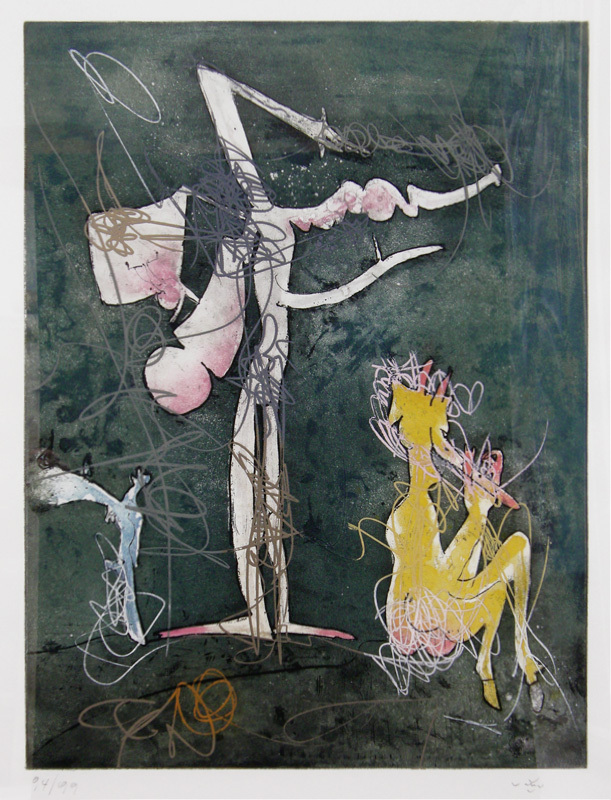
19th, 20th & 21st Century Fine Prints
707-546-7352 · fax 707-546-7924 · web: www.annexgalleries.com · email: artannex@aol.com
Flute et Flutiste by Roberto Sebastian Matta

Flute et Flutiste
Roberto Sebastian Matta
Flute et Flutiste
Roberto Sebastian Matta
1911 - 2002 (biography)In 1969 Roberto Sebastian Matta, who by now often went simply as “Matta,” had been living in Italy for two decades and had made his mark on the art world with his Abstract, Surrealist compositions. Never quite falling into a purist vision of either category, his style was entirely his own and had gained a following not only in the leading European and American markets but in his homeland, Chile, and throughout Latin America.
In “Flute et Flutiste” two biomorphic figures occupy a forest-green landscape, appearing like circus performers in a dusky clearing, one dancing, one playing a pipe or flute. Matta employs looping, thin lines of color aquatint that unspool around the figures in a frenetic display of energy. The juxtaposition of the softly textured background and the stark, bright, alien figures exemplifies Matta’s vision of the world he occupies. His work continues to influence artists in all mediums the world over.
Matta (Roberto Sebastian Antonio Matta Echaurren), painter, muralist, printmaker, draughtsman and ceramist, was born in Santiago, Chile on November 11, 1911. His formal studies began in architecture, and he received his diploma in architectural studies in 1932 from La Universidad Catolica de Santiago in Chile. This coincided with his apprecticeship under visiting Swiss-French architect Le Corbusier, working on his proposal for the Ville Radieuse in 1930. His interests soon veered away from architecture and he began his artistic career as a draughtsman. On the advice of friend Andre Breton, he moved to Paris in 1933 and traveled throughout Europe between 1935 and 1937, meeting Federico Garcia Lorca who introduced him to Salvador Dali. Thanks to Dali, Matta joined the Surrealist movement in 1937 and contributed to the their publications.
He began painting in 1938 and that same year he participated in the Paris Exposicion International du Surrealism. He was excluded from the Surrealist group in 1947 but was reinstated in 1959. Exiled to the United States in 1939 with the onset of World War II, Matta settled in New York where his biomorphic, alien landscapes and figures gained popularity among artists and galleriests. His first solo exhibition in the US took place at the Julian Levy Gallery in 1940.
Between 1943 and 1947 Matta worked at Atelier 17, then located in The New School, as many European and American artists did during the war. Stanley William Hayter's experimental workshop proved to be a boon for the artist whose style became more solid through his work with new printmaking tools and the atmosphere of discovery. He would return to work there from time to time in the 1950s.


